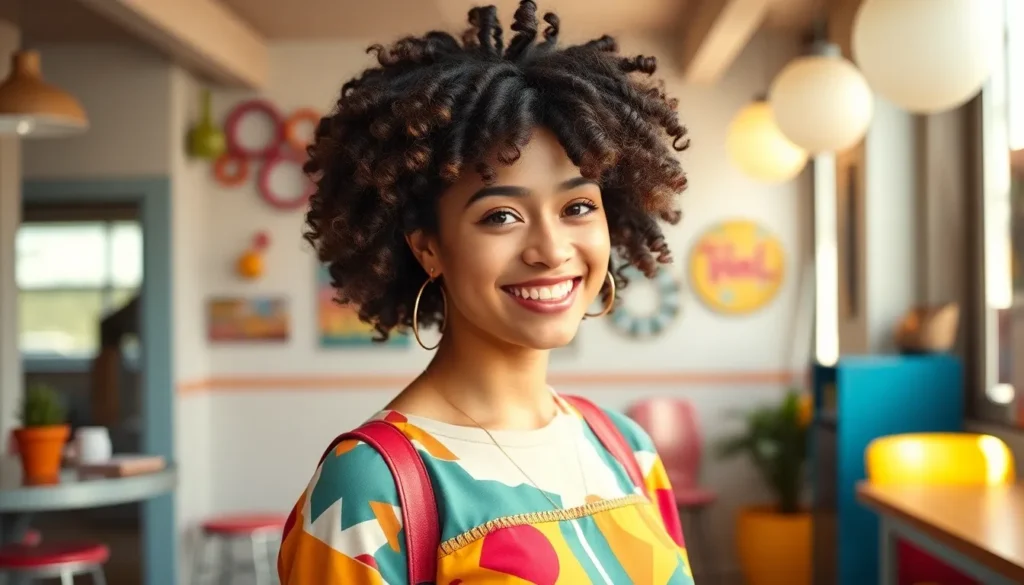Remember those gloriously voluminous zigzag waves that dominated the ’80s and ’90s? Crimped hair is making a major comeback, and we’re absolutely here for it. This textured hairstyle creates incredible volume and adds serious personality to any look – whether you’re channeling full retro vibes or putting a modern twist on the classic crimp.
We’ve seen celebrities and influencers embracing this bold texture on red carpets and social media, proving that crimped hair isn’t just a nostalgic throwback. It’s a versatile styling technique that works on virtually any hair length or type, from subtle waves to dramatic zigzag patterns that turn heads.
Whether you’re curious about recreating that iconic ’80s look or want to experiment with contemporary crimping techniques, we’ll guide you through everything you need to know. From choosing the right tools to mastering different crimping styles, you’ll discover why this textured trend deserves a spot in your styling rotation.
What Is Crimped Hair and Why Is It Making a Comeback
Crimped hair creates distinctive zigzag waves through specialized tools that press textured plates against strands. We achieve this unique pattern using crimping irons with ridged metal plates that form accordion-like bends throughout the hair shaft. The technique originated in the 1980s when celebrities like Madonna and Cyndi Lauper popularized the bold, voluminous texture.
Today’s crimped hair revival stems from social media platforms where Gen Z and millennial influencers showcase updated versions of this retro style. TikTok videos featuring crimped hair tutorials have garnered over 47 million views since 2022, demonstrating the technique’s widespread appeal. Instagram posts tagged with #crimpedhair increased by 340% between 2021 and 2025, according to social media analytics data.
Modern crimping techniques offer more versatility than their 1980s predecessors through adjustable heat settings and varied plate sizes. We can create subtle texture with wider plates or dramatic zigzag patterns using narrow crimping attachments. Current crimping tools feature ceramic and tourmaline coatings that reduce heat damage while maintaining longer-lasting results.
Celebrity endorsements have accelerated crimped hair’s mainstream acceptance among contemporary audiences. Bella Hadid wore crimped waves to the 2025 Met Gala, while Dua Lipa featured the style in her “Physical” music video. Fashion weeks in Paris and Milan showcased crimped textures on runway models, cementing the trend’s high-fashion credibility.
Hair texture trends cycle approximately every 20 to 30 years, explaining why crimped styles resonate with today’s fashion-conscious consumers. We’re witnessing a broader revival of 1980s and 1990s aesthetics across beauty, fashion, and pop culture. This nostalgic wave includes other textured hairstyles like perms, finger waves, and teased volumes that complement crimped hair’s dramatic appeal.
Essential Tools You Need to Create Perfect Crimped Hair
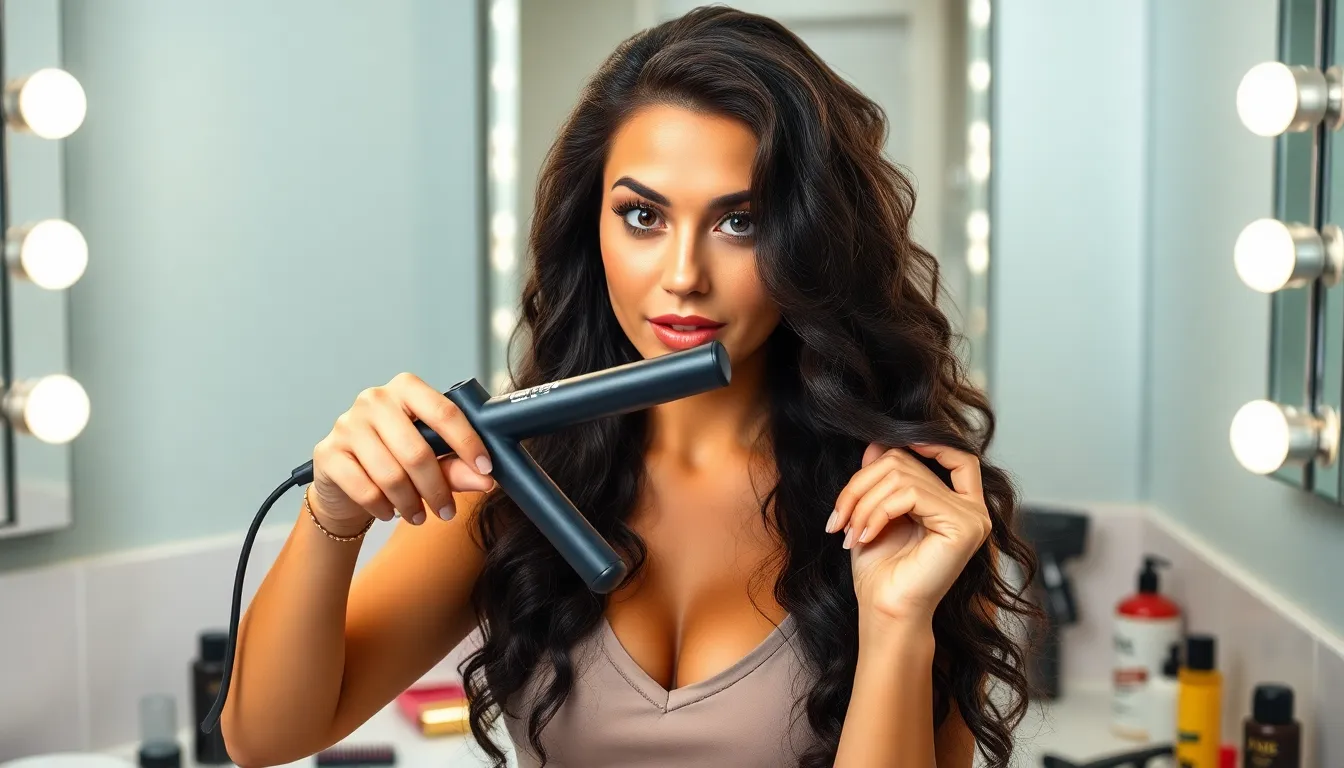
Getting the right equipment makes all the difference when creating those perfect crimped waves. We’ll walk you through the must-have tools that’ll help you achieve salon-quality results at home.
Hair Crimping Iron Selection
Crimping iron plate size determines the final texture of your waves. Wide plates (1.5 to 2 inches) create loose, voluminous crimps perfect for thick or long hair, while narrow plates (0.5 to 1 inch) produce tight, defined zigzag patterns ideal for fine hair or detailed styling. Professional crimping irons like the Hot Tools Professional Crimping Iron and CHI Ceramic Crimping Iron offer consistent heat distribution across titanium or ceramic plates.
Temperature control features protect your hair from excessive heat damage. Quality crimping irons provide adjustable heat settings ranging from 250°F for fine hair to 450°F for coarse, thick textures. Digital displays show exact temperatures, while some models include automatic shut-off functions after 30 to 60 minutes of inactivity.
Plate material affects both styling results and hair health. Ceramic plates distribute heat evenly and reduce frizz, titanium plates heat up quickly and work well on resistant hair types, while tourmaline-infused plates emit negative ions that seal the hair cuticle and add shine.
Heat Protectant Products
Thermal protection sprays shield your hair from temperatures up to 450°F. Products like TRESemmé Thermal Creations Heat Tamer Spray and CHI 44 Iron Guard create a protective barrier between your hair and the crimping iron. Apply these sprays to damp hair before blow drying and again on dry hair before crimping.
Leave-in treatments provide both protection and styling benefits. Creams like Redken Pillow Proof Blow Dry Express Primer and It’s a 10 Miracle Leave-In Product contain heat-activated ingredients that strengthen hair fibers while reducing styling time. These products also add moisture and prevent the brittle texture that can result from frequent heat styling.
Oil-based protectants work best for extremely damaged or chemically treated hair. Lightweight oils such as argan oil serums and coconut oil sprays penetrate the hair shaft to provide deep protection while adding glossy finish to crimped styles.
Styling Accessories
Wide-tooth combs separate crimped sections without disrupting the wave pattern. Use these combs before crimping to detangle hair and after styling to gently blend harsh lines between crimped sections. Carbon fiber combs resist heat and won’t melt if accidentally touched by hot styling tools.
Hair clips and sectioning tools organize your styling process efficiently. Butterfly clips, duck bill clips, and sectioning picks help you work through your hair methodically, ensuring every strand gets properly crimped. Professional stylists recommend using at least 6 to 8 clips for medium to long hair lengths.
Texturizing sprays enhance and extend your crimped hairstyle. Products like Bumble and Bumble Surf Spray and Ouai Wave Spray add grit and hold to freshly crimped hair, preventing the waves from falling flat throughout the day. These sprays also work as refresher products on day-two crimped styles.
Step-by-Step Guide to Crimping Your Hair at Home
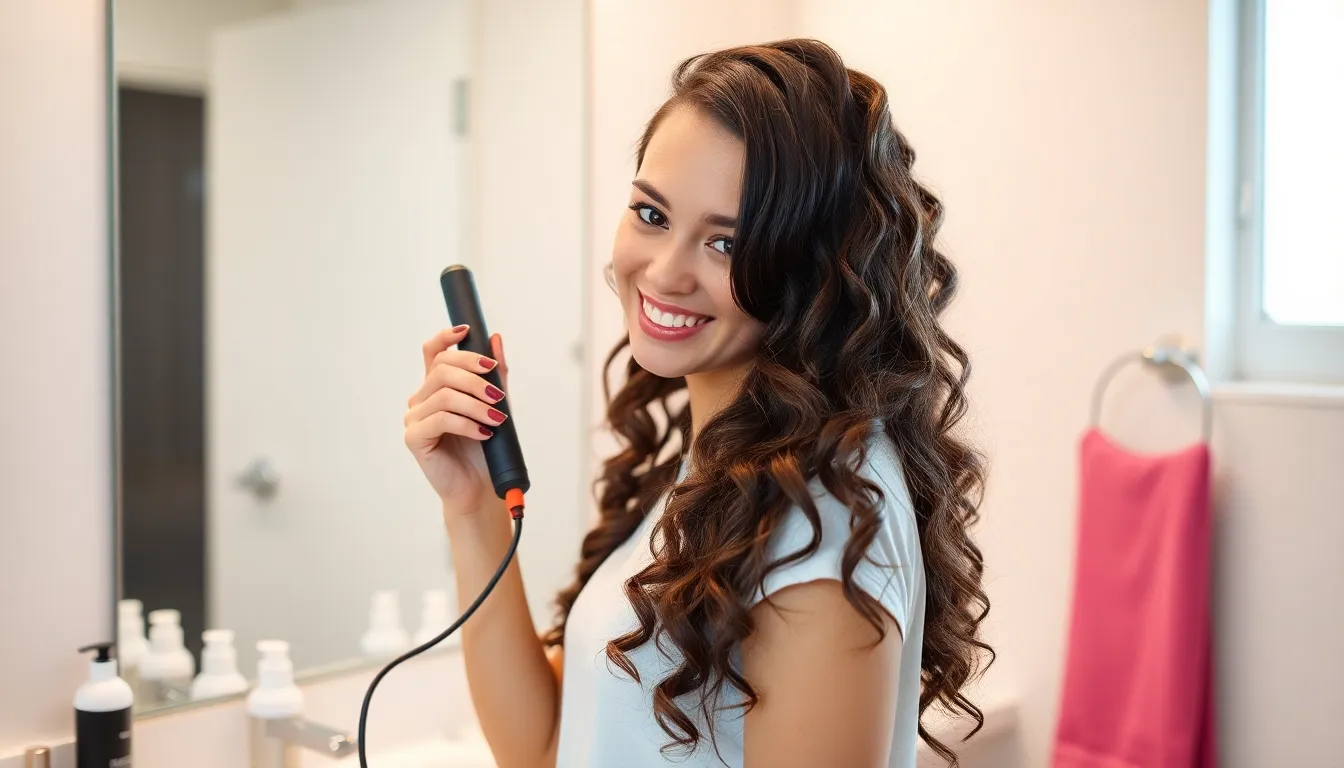
Now that you’ve gathered all the essential tools, let’s walk through the process of creating perfect crimped waves that rival professional salon results.
Preparation and Hair Sectioning
Start with completely dry, clean hair for optimal crimping results. Freshly washed hair holds texture better and prevents product buildup from interfering with the crimping process. Apply a heat protectant spray from mid-length to ends, ensuring even coverage throughout your hair.
Divide your hair into manageable sections using horizontal partings about 1 to 2 inches wide. Clip upper sections away with hair clips to keep them out of your working area. Work systematically from the bottom layer upward for consistent wave patterns.
Comb each section smooth before crimping to remove tangles and ensure uniform texture. Use a wide-tooth comb to gently detangle without creating static or frizz. This preparation step significantly impacts the final crimped appearance.
Crimping Technique and Temperature Settings
Set your crimping iron between 250°F to 300°F depending on your hair type and thickness. Fine or damaged hair requires lower temperatures around 250°F, while thick or coarse hair can handle settings up to 350°F for stubborn strands.
Place the crimping iron close to your roots but not directly against your scalp to avoid burns. Clamp down firmly and hold for 3 to 5 seconds before moving to the next section. Overlap each crimp slightly to create seamless wave continuity.
Work in small subsections of about half an inch wide for maximum volume and definition. Starting from the back, crimp each piece methodically before moving forward. Avoid re-crimping the same section as this can cause heat damage and flatten your waves.
Move the iron straight down rather than pulling or dragging it through your hair. This technique creates consistent zigzag patterns without stretching or damaging the hair shaft. Complete one side before moving to the other for balanced results.
Finishing Touches and Setting Spray
Allow crimped sections to cool completely before touching or manipulating them. Hot hair continues to set its shape during the cooling process, so patience ensures longer lasting waves. Use this time to crimp remaining sections.
Gently separate larger crimped pieces with your fingers to create more volume and texture. Avoid brushing or combing through crimped hair as this destroys the wave pattern and creates frizz instead of definition.
Apply texturizing spray throughout your crimped hair while scrunching gently upward. This step adds hold and prevents waves from falling flat during the day. Focus on mid-lengths and ends where the crimping is most prominent.
Finish with a light misting of flexible hold hairspray from 8 to 10 inches away. This final step locks in your crimped texture without creating stiffness or crunchiness that can make hair look unnatural.
Different Types of Crimped Hair Styles to Try
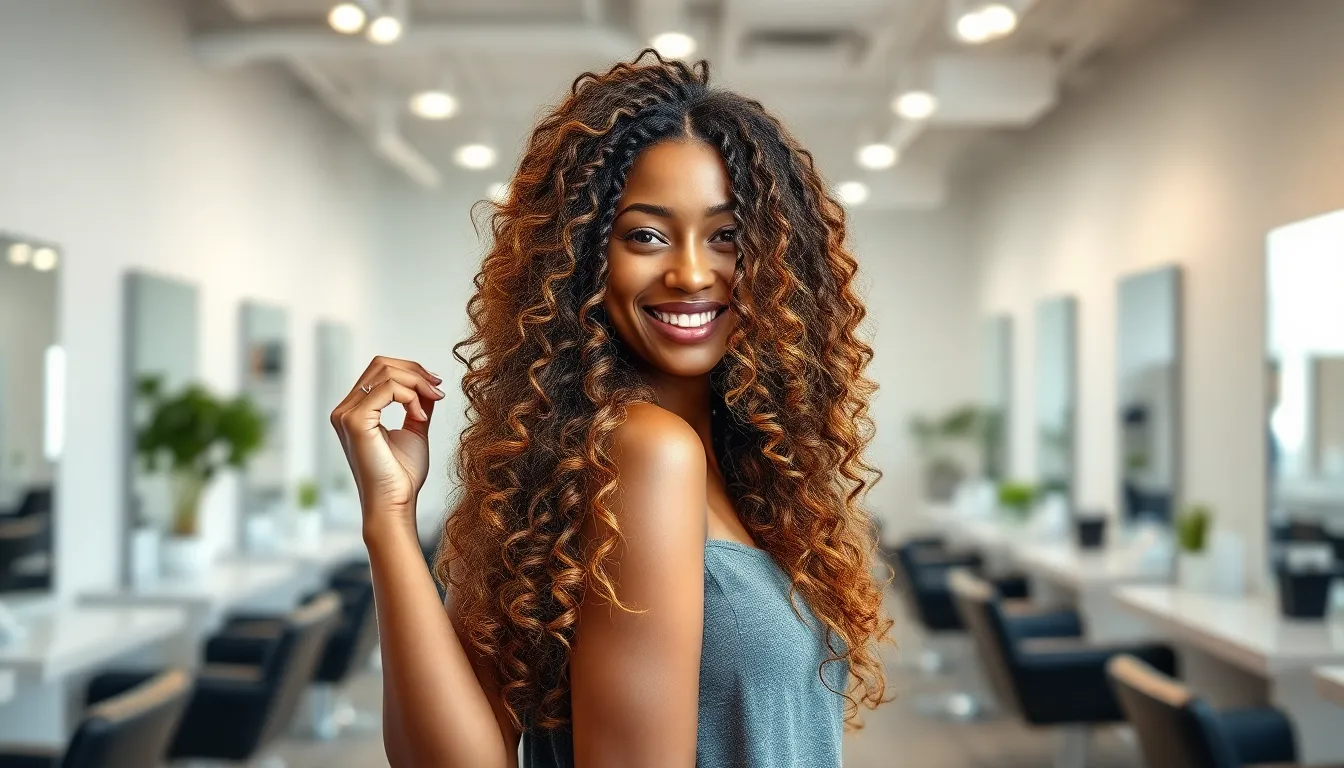
Now that we’ve mastered the basics of crimping, let’s explore the diverse styling options that showcase this versatile texture’s full potential.
Zigzag Crimped Hair Patterns
Classic zigzag crimps create the most recognizable crimped hair pattern with sharp, defined waves that run uniformly throughout your strands. We achieve this look using standard crimping irons with medium sized plates that produce consistent wave formations across each section. Start at your roots and work downward in overlapping sections to ensure seamless zigzag continuity.
Wide zigzag patterns offer a more relaxed take on traditional crimping by using larger plate crimping irons that create broader wave formations. These patterns work exceptionally well on longer hair lengths where the extended waves can fully develop their distinctive shape. We recommend this style for those seeking crimped texture without overwhelming volume.
Tight zigzag crimps deliver maximum texture density through smaller crimping iron plates that create condensed wave patterns. This intensive crimping approach produces dramatic volume and works particularly well as accent pieces around your face or crown area. Section your hair into quarter inch pieces for the most defined tight zigzag results.
Micro Crimped Hair Texture
Ultra fine crimping transforms hair into an incredibly textured surface using specialty micro crimping tools with tiny plates. We create this delicate crimped texture by working with very small sections and applying consistent pressure for uniform micro wave distribution. This technique adds subtle volume while maintaining a sophisticated appearance.
Root only micro crimping focuses texture exclusively at your hair’s base to create lift without full length commitment to crimped styles. Apply micro crimping to the first two inches of hair from your scalp to achieve natural looking volume that supports any hairstyle. We find this approach perfect for adding body to fine or flat hair types.
Selective micro crimping involves strategically placing micro textured sections throughout your hairstyle for dimensional interest. Choose exact strands around your face, underneath layers, or within braided sections to incorporate subtle crimped accents. This controlled approach lets you experiment with crimped textures while maintaining versatility in your overall look.
Mixed Texture Crimped Hair Looks
Crimped and straight combinations blend smooth sections with crimped areas to create ever-changing textural contrast throughout your hairstyle. We alternate between leaving certain sections uncrimped while heavily texturing others to achieve balanced visual interest. This technique works particularly well when crimping underneath layers while keeping top sections smooth.
Loose waves with crimped accents incorporate traditional crimping into already wavy or curled hairstyles for enhanced texture complexity. Apply crimping selectively to exact curl sections or use it to add grip and hold to loose wave patterns. We recommend focusing crimped accents around your face or at hair ends for the most flattering mixed texture results.
Braided crimped textures combine crimping with various braiding techniques to create intricate textured styles with lasting hold. Crimp sections before braiding to add grip and volume, or crimp hair after removing braids for layered texture patterns. These mixed approaches showcase crimped hair’s versatility while creating unique styling combinations that stand out from standard crimped looks.
Celebrity Crimped Hair Looks That Defined the Decades

Celebrity crimped hair moments have shaped beauty trends for decades, showcasing the enduring appeal of textured waves. We’ve witnessed countless stars embrace this bold styling choice from the 1980s to today’s red carpets.
Madonna’s Iconic 80s Crimped Hair
Madonna revolutionized crimped hair styling during the peak of her 1980s fame with her signature bleached blonde zigzag waves. Her crimped texture became synonymous with the era’s rebellious spirit, appearing in music videos like “Papa Don’t Preach” and “Material Girl” where she paired the dramatic waves with bold makeup and statement accessories.
The Queen of Pop’s crimped hair techniques varied from tight, densely packed waves to looser, more voluminous textures depending on the occasion. She often combined her crimped locks with scrunchies, headbands, and hair clips to create layered looks that defined 80s fashion. Madonna’s influence extended beyond music as her crimped hairstyles inspired millions of fans to recreate the textured look at home using specialized crimping tools.
Her most memorable crimped hair moment occurred during the 1984 MTV Video Music Awards where she wore platinum blonde crimped waves that cascaded past her shoulders. The styling choice perfectly complemented her white wedding dress performance and cemented crimped hair as a mainstream trend rather than an underground fashion statement.
Modern Red Carpet Crimped Hair Styles
Contemporary celebrities have reimagined crimped hair with sophisticated techniques that blend retro charm with modern elegance. Bella Hadid’s crimped updo at the 2021 Met Gala featured intricate micro crimped textures woven into an elaborate sculptural style that photographers captured from every angle. Her stylist used selective crimping methods to create dimensional interest while maintaining the formal event’s glamorous aesthetic.
Zendaya showcased crimped hair versatility at multiple premieres by incorporating textured waves into sleek ponytails and half up styles. Her approach demonstrates how crimped textures can enhance contemporary hairstyles without appearing dated or costume like. The actress often pairs her crimped looks with natural makeup to let the textured hair serve as the focal point.
Dua Lipa’s music video appearances feature crimped hair that spans from subtle wave accents to full head textured styles reminiscent of the 80s era. Her styling team creates modern interpretations by mixing crimped sections with straight pieces or incorporating the texture into braided elements. These contemporary applications prove that crimped hair continues evolving beyond its original decade of popularity.
Recent award shows have featured celebrities like Lizzo and SZA wearing crimped textures that celebrate natural hair movement while adding structural interest through specialized styling techniques.
Best Hair Types and Lengths for Crimped Hair Success
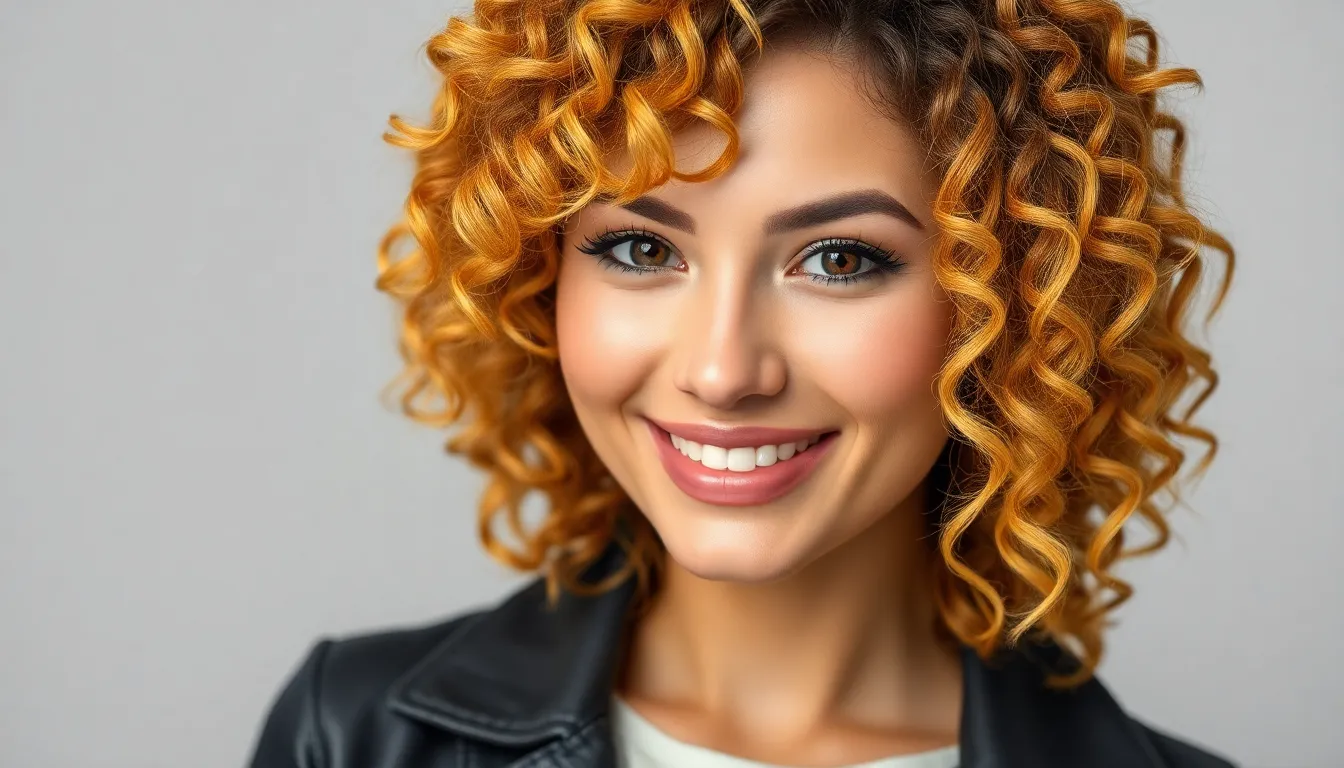
Finding the right combination of hair type and length determines whether your crimped hairstyle achieves maximum impact. Different textures and lengths respond uniquely to crimping techniques and require exact approaches for optimal results.
Fine Hair Crimping Considerations
Fine hair responds exceptionally well to crimping because the technique adds instant volume and texture that naturally thin strands often lack. We recommend using lower heat settings between 250-300°F to prevent damage to delicate fine hair fibers. Start with smaller plate sizes to create tighter waves that give fine hair more body and staying power.
Apply volumizing mousse or texturizing spray before crimping to enhance grip and longevity. Fine hair benefits from crimping every other section rather than every strand to prevent overwhelming the natural texture. Work with quarter-inch sections for fine hair to ensure each piece receives adequate heat and pressure for lasting waves.
Thick Hair Crimping Strategies
Thick hair requires higher temperatures between 350-400°F and longer crimping time to penetrate dense strands effectively. We suggest using wider plate crimping irons to cover more surface area and reduce styling time. Divide thick hair into horizontal sections no more than one inch wide to ensure even heat distribution throughout each layer.
Pre-treat thick hair with heat protectant and anti-humidity products to maintain crimp definition in challenging weather conditions. Allow each crimped section to cool completely in your palm before moving to the next area. Thick hair holds crimped patterns longer but needs extra time during the initial styling process for optimal results.
Short vs Long Crimped Hair Results
Short hair creates dramatic texture changes with crimping because waves appear more concentrated and intense across limited surface area. Bobs and pixie cuts develop edgy geometric patterns that frame facial features boldly. We find short crimped styles work best with micro-crimping techniques that add texture without creating excessive volume.
Long hair showcases crimped waves with flowing movement and creates stunning visual impact when styled properly. Crimped long hair requires sectioning into at least six horizontal layers to ensure consistent wave patterns from roots to ends. Long lengths benefit from alternating crimp directions to prevent monotonous parallel lines and create natural-looking texture variation.
| Hair Length | Crimping Time | Best Plate Size | Heat Setting |
|---|---|---|---|
| Short (chin length) | 15-20 minutes | Small (½ inch) | 300-350°F |
| Medium (shoulder) | 25-35 minutes | Medium (¾ inch) | 325-375°F |
| Long (past shoulders) | 40-60 minutes | Large (1 inch) | 350-400°F |
Common Crimped Hair Mistakes to Avoid
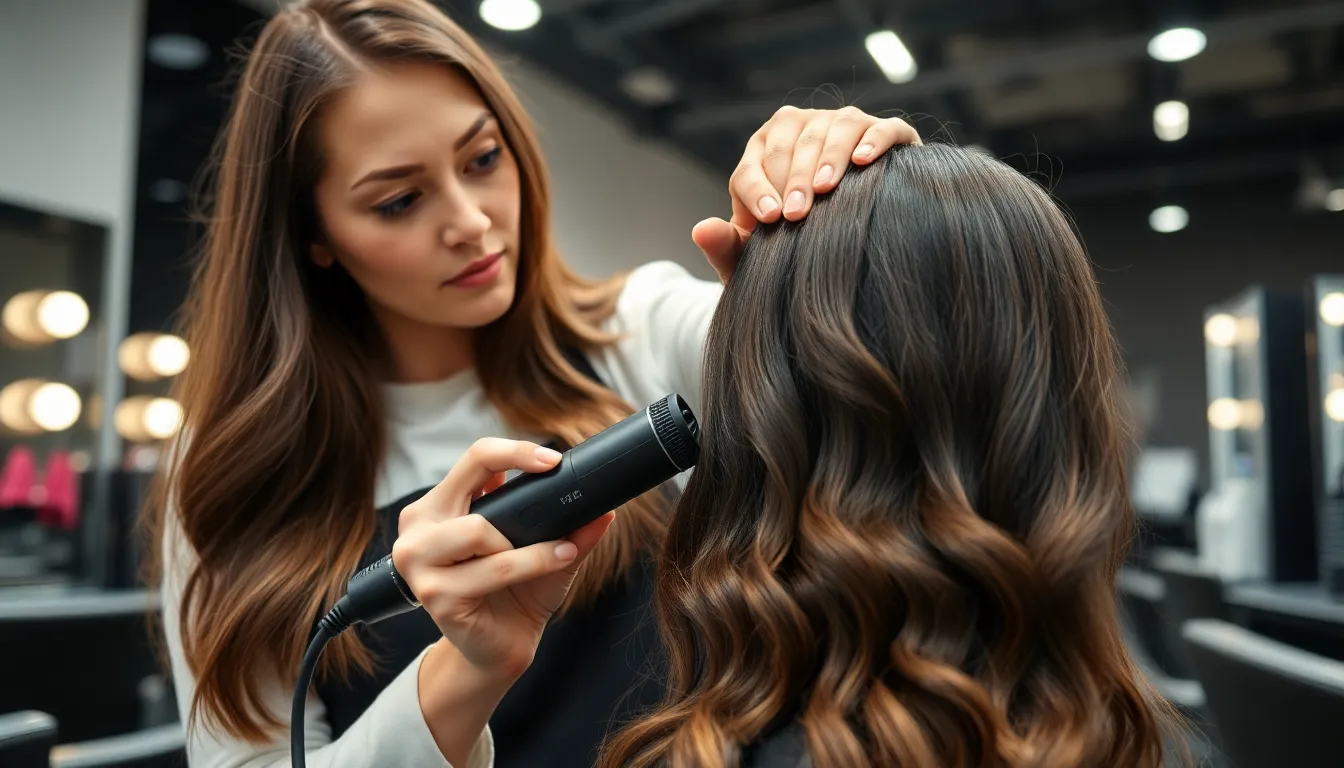
Even experienced stylists can stumble when creating crimped textures. We’ve identified the most frequent errors that can sabotage your crimped hair goals.
Overheating and Heat Damage
Using excessive temperatures ranks as the top crimping mistake we encounter. Fine hair requires temperatures between 250-300°F, while thick hair performs best at 350-380°F maximum. Exceeding these ranges causes protein damage that makes crimped waves appear frizzy and brittle.
Holding the iron too long creates another common heat damage scenario. We recommend 3-5 seconds per section for fine hair and 5-8 seconds for thick textures. Longer contact times don’t improve wave formation but increase breakage risk significantly.
Skipping cooling time between sections prevents proper wave set formation. Each crimped section needs 10-15 seconds to cool completely before moving or separating the hair. Rushing this process causes waves to fall flat within hours.
Improper Product Application
Applying too much heat protectant weighs down crimped textures and reduces wave definition. We suggest using a dime-sized amount for shoulder-length hair, working it through damp strands before blow-drying completely. Excess product creates a barrier that prevents proper crimping iron contact.
Using the wrong product timing affects crimp longevity dramatically. Heat protectant goes on damp hair before drying, texturizing spray applies to dry hair before crimping, and finishing spray comes after the entire style is complete. Mixing this order reduces hold and increases heat damage potential.
Choosing heavy styling products like creams or oils eliminates crimped texture entirely. Lightweight mousses, sea salt sprays, and volumizing products work best for maintaining zigzag patterns. Heavy formulations smooth out the crimped waves we’re trying to create.
Wrong Crimping Iron Size Selection
Using plates that are too wide for your hair length creates ineffective wave patterns. Short hair (chin-length and above) needs 1/2-inch plates, medium hair works with 3/4-inch plates, and long hair can handle 1-inch plates maximum. Oversized plates don’t grip shorter sections properly.
Selecting plates that are too narrow for thick hair density wastes time and creates uneven results. Dense hair requires wider plates to crimp adequate sections efficiently. Narrow plates on thick hair create patchy coverage that looks unprofessional.
Ignoring plate material differences affects heat distribution and styling results. Ceramic plates provide even heating for consistent waves, while titanium plates heat faster but require careful temperature monitoring. Cheap metal plates create hot spots that damage hair unevenly.
How to Maintain and Care for Your Crimped Hair
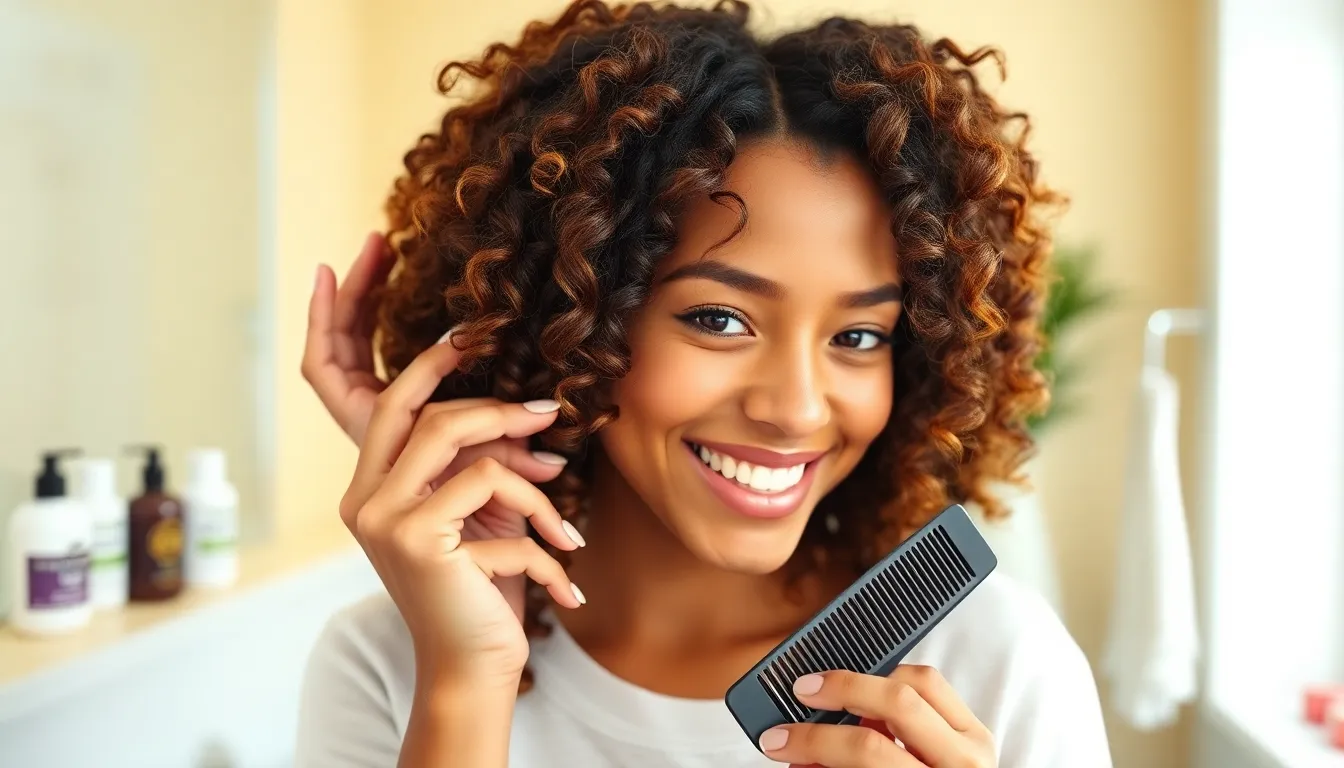
Crimped hair requires exact maintenance techniques to preserve its distinctive texture and prevent damage. We’ve developed proven strategies that keep your zigzag waves looking fresh while protecting your hair’s health.
Daily Maintenance Routine
Gentle brushing techniques preserve your crimped texture throughout the day. We recommend using a wide-tooth comb or your fingers to separate sections instead of traditional brushes that flatten waves. Start from the ends and work upward to prevent breakage and maintain volume.
Moisture replenishment keeps crimped hair healthy and bouncy. Apply a lightweight leave-in conditioner focusing on mid-lengths and ends where crimping creates the most texture. We suggest using products with ingredients like argan oil or coconut oil that won’t weigh down your waves.
Touch-up styling maintains wave definition when needed. Keep a small travel-sized texturizing spray handy for areas that lose their crimp throughout the day. We find that lightly misting flattened sections and scrunching with your hands revives the zigzag pattern effectively.
Heat-free reshaping extends your style’s lifespan. When sections begin to lose their texture, twist small pieces around your finger while slightly damp and allow them to air dry. This technique recreates crimped movement without additional heat damage.
Overnight Protection Methods
Silk pillowcases reduce friction that destroys crimped texture while you sleep. We recommend investing in mulberry silk or satin alternatives that allow hair to glide smoothly instead of catching and flattening. This simple switch can extend your crimped style by 2-3 days.
Protective hairstyles maintain wave integrity overnight. Create 2-3 loose braids before bed to preserve crimped sections without creating unwanted creases. We suggest starting the braids below your ears to avoid flattening the volume at your roots.
Hair wrapping techniques shield crimped styles from pillow friction. Wrap your hair loosely in a silk scarf or buff, ensuring the fabric covers all crimped sections. We find this method particularly effective for shorter crimped styles that can’t be braided.
Strategic positioning prevents compression damage during sleep. Sleep with your head slightly elevated using an extra pillow to reduce the weight pressing on your crimped hair. We recommend the “pineapple” method where you gather hair very loosely at the very top of your head with a soft scrunchie.
Refreshing Second-Day Crimped Hair
Water-based revival sprays restore bounce to day-old crimped hair. Mix equal parts water and leave-in conditioner in a spray bottle and mist lightly over flattened areas. We suggest focusing on the mid-lengths where crimped texture typically loses definition first.
Finger scrunching reactivates dormant wave patterns effectively. Apply a small amount of curl cream to damp hands and scrunch sections that have lost their zigzag shape. We find this technique works best when hair is slightly damp rather than completely dry.
Strategic re-crimping targets only the most flattened sections. Use your crimping iron on the lowest effective temperature setting to touch up 2-3 pieces around your face or crown area. We recommend limiting this to prevent heat overexposure while maintaining overall style integrity.
Dry shampoo application adds texture and absorbs excess oils. Spray dry shampoo at the roots and work through with your fingers to create grip and volume in crimped hair. We suggest using this technique on day two or three to extend your style’s lifespan while adding beneficial texture.
Alternative Methods to Achieve Crimped Hair Without Heat

Creating stunning crimped textures doesn’t always require hot styling tools. We’ll explore gentle techniques that protect your hair while delivering beautiful waves and volume.
Braiding Techniques for Natural Crimp
Multiple small braids create the most effective heat-free crimping method for achieving zigzag patterns. We recommend sectioning damp hair into 10 to 15 small portions and braiding each section tightly from root to tip. Sleeping with these braids overnight produces natural crimped waves that rival traditional heated methods.
French braid variations offer different textures depending on your sectioning approach. Creating 4 to 6 Dutch braids on slightly damp hair generates wider crimped patterns similar to large-plate crimping irons. Loosening the braids after 6 to 8 hours reveals voluminous waves with lasting hold.
Micro braiding techniques work exceptionally well for fine hair types seeking maximum volume. We suggest braiding tiny sections no wider than your pinky finger for tight, detailed crimps. This method requires 15 to 20 small braids but creates incredibly dense texture that lasts 2 to 3 days.
Pin curl braiding combines traditional techniques with modern styling needs. Braiding small sections and then pinning them into tight coils against your scalp intensifies the crimping effect. Removing the pins and gently separating the braids after drying reveals dramatic zigzag patterns.
Hair Accessories for Temporary Texture
Crimping combs offer instant texture without any heat damage or lengthy prep time. These specialized tools feature zigzag teeth that create temporary crimped effects by backcombing small sections. We find they work best on clean, dry hair with light texturizing spray for hold.
Hair wrapping strips made from fabric or foam create consistent crimped patterns overnight. Wrapping damp hair around these flexible strips and securing them with clips produces even waves. Removing the strips in the morning reveals uniform crimps that last throughout the day.
Bobby pin techniques transform ordinary accessories into crimping tools for targeted texture. We recommend weaving small sections of hair through multiple bobby pins in zigzag patterns. This method works particularly well for adding crimped accents to exact areas rather than full-head styling.
Headband curling methods create loose crimped waves using soft fabric headbands. Wrapping slightly damp hair around a stretchy headband and tucking the ends underneath produces gentle waves with crimped characteristics. This technique requires 4 to 6 hours to set but creates natural-looking texture.
Hair rollers in zigzag patterns combine traditional setting methods with crimping goals. Using small foam rollers and rolling hair in alternating directions creates varied texture similar to crimped styles. We suggest using 12 to 16 rollers for optimal coverage and removing them after complete drying.
Crimped Hair Products That Enhance Your Style

Selecting the right products elevates your crimped hair from ordinary to extraordinary. We’ve compiled the most effective formulations that work specifically with crimped textures to maximize volume, definition, and longevity.
Volumizing Mousses and Texturizing Sprays
Volumizing mousses create the perfect foundation for long-lasting crimped styles. Lightweight formulas like Pantene Pro-V Volume Mousse and TRESemmé Flawless Curls Mousse distribute evenly through damp hair before crimping, adding body without weighing down your waves. These mousses contain polymers that expand when heated, working synergistically with crimping irons to enhance texture depth.
Texturizing sprays transform flat crimped sections into dimensional masterpieces. Products such as Ouai Wave Spray and Bumble and Bumble Surf Spray contain sea salt minerals that grip each crimped ridge, preventing waves from falling flat throughout the day. We recommend applying these sprays to dry hair after crimping, focusing on mid-lengths and ends where texture needs the most support.
Pre-styling texturizers prepare your hair for optimal crimp formation. Formulations like DevaCurl Frizz-Free Volumizing Foam and Moroccanoil Volumizing Mousse create microscopic texture on the hair shaft, allowing crimping plates to grab and mold each section more effectively. Apply these products section by section as you work through your crimping routine for maximum coverage.
Root-lifting sprays target the foundation of voluminous crimped styles. Specialized products such as Kenra Volume Spray and Matrix Vavoom Height of Glam contain ingredients that create lift at the scalp, essential for preventing crimped hair from appearing flat at the crown. Spray directly onto roots before blow-drying, then proceed with your crimping technique.
Hold-Improving Gels and Creams
Flexible hold gels maintain wave definition without creating stiffness. Products like DevaCurl Ultra Defining Gel and Ouai Curl Crème contain humidity-resistant polymers that lock crimped patterns in place while allowing natural movement. These formulations work best when applied to slightly damp hair before crimping, creating a protective barrier that enhances wave longevity.
Styling creams provide moisture and hold simultaneously for healthier crimped results. Formulations such as Shea Moisture Coconut and Hibiscus Curl Improving Smoothie and Cantu Coconut Curling Cream nourish hair while defining each crimped section. We apply these products sparingly to prevent buildup, focusing on areas prone to frizz and flyaways.
Memory styling gels help recreate yesterday’s crimped perfection. Advanced formulas like Aussie Instant Freeze Gel and TRESemmé Tres Two Extra Hold Hair Gel contain shape-memory technology that allows you to reactivate hold with minimal water application. Simply mist crimped sections lightly and scrunch to revive wave definition on day two.
Anti-humidity creams protect crimped styles in challenging weather conditions. Specialized products such as John Frieda Frizz Ease Extra Strength Serum and Moroccanoil Frizz Control contain silicones that create an invisible shield around each crimped strand. These creams prevent moisture from penetrating the hair shaft and disrupting your carefully crafted texture patterns.
Conclusion
We’ve witnessed crimped hair’s remarkable transformation from an ’80s icon to today’s versatile styling statement. This textured trend offers endless possibilities whether you’re seeking dramatic volume subtle accents or complete style reinvention.
The beauty of crimped hair lies in its adaptability across different hair types lengths and personal aesthetics. With proper tools techniques and products anyone can master this look while maintaining healthy hair.
Whether you choose heat styling methods or explore gentle no-heat alternatives the key is understanding your hair’s unique needs and experimenting with different approaches. We encourage you to embrace this bold texture and make it your own – after all crimped hair is about expressing confidence and creativity through your personal style.
Frequently Asked Questions
What is crimped hair and how is it created?
Crimped hair features distinctive zigzag waves created using specialized crimping irons with ridged plates. The tool is pressed onto small sections of hair to create textured, accordion-like patterns. Modern crimping irons offer adjustable heat settings and various plate sizes to achieve different wave intensities while minimizing heat damage.
Why is crimped hair making a comeback?
Crimped hair is experiencing a revival due to the cyclical nature of beauty trends, which typically return every 20-30 years. Social media platforms like TikTok and Instagram have accelerated its popularity through tutorials and celebrity endorsements. The current ’80s and ’90s aesthetic revival in fashion has also contributed to its mainstream acceptance.
What tools do I need to crimp my hair at home?
Essential tools include a quality crimping iron with temperature control, heat protectant spray, wide-tooth comb, hair clips for sectioning, and texturizing spray for hold. Choose crimping irons with ceramic or titanium plates and adjustable heat settings. Additional accessories like root-lifting spray and flexible hold hairspray help maintain the style.
Can all hair types be crimped successfully?
Yes, but techniques vary by hair type. Fine hair benefits from lower heat settings (250-300°F) and smaller plate sizes to enhance volume without damage. Thick hair requires higher temperatures (300-350°F) and wider plates for effective styling. Both short and long hair can be crimped, with different visual effects.
How do I maintain crimped hair overnight?
Use silk or satin pillowcases to reduce friction and preserve wave integrity. Create loose protective styles like low ponytails or braids to prevent flattening. Apply lightweight leave-in conditioner for moisture and use texturizing spray for touch-ups. Avoid sleeping directly on crimped sections to maintain definition.
Are there heat-free methods to achieve crimped hair?
Yes, several techniques create crimped effects without heat damage. Try braiding damp hair in multiple small braids, using crimping combs, or wrapping hair around bobby pins in zigzag patterns. Hair wrapping strips and zigzag hair rollers also create temporary crimped textures while protecting hair health.
What products work best for crimped hair?
Volumizing mousses, texturizing sprays, and flexible hold gels are ideal for crimped styles. Pre-styling texturizers add grip and definition, while root-lifting sprays enhance volume. Memory styling gels help maintain wave patterns, and anti-humidity creams protect against weather-related frizz and style loss.
How long does crimped hair typically last?
Properly crimped hair can last 1-3 days depending on hair type, products used, and environmental factors. Fine hair may lose definition sooner, while coarse hair holds crimped patterns longer. Using quality styling products, proper technique, and overnight protection methods can extend the style’s longevity significantly.

